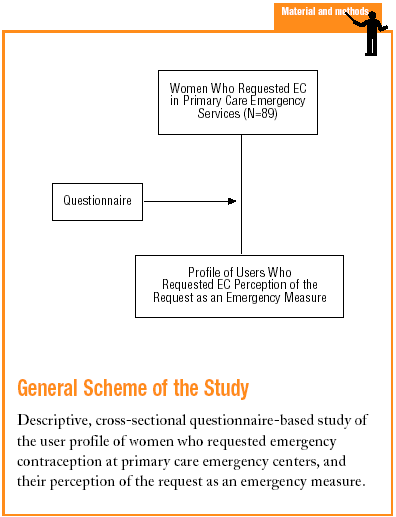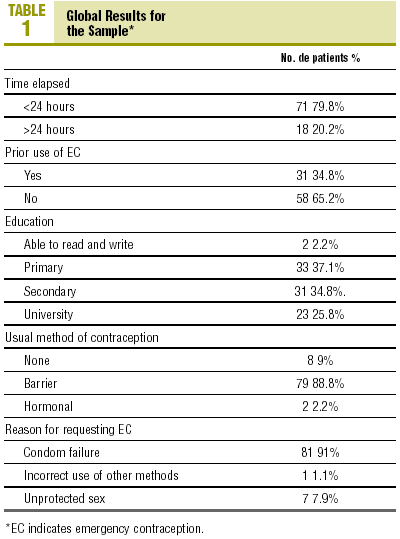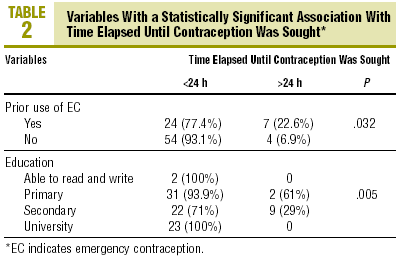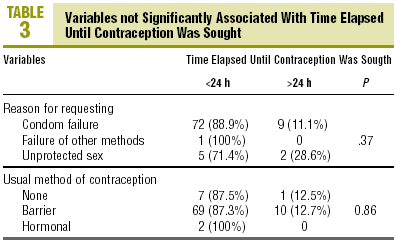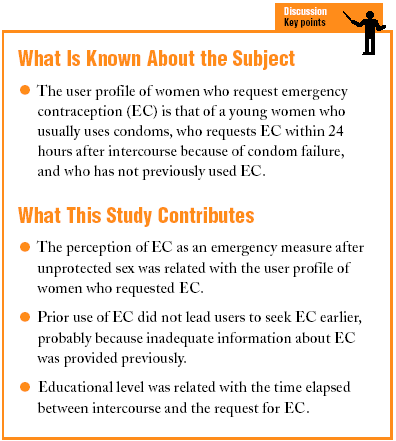Introduction
Emergency contraception (EC) can be defined as the use of a drug or device to prevent pregnancy after unprotected sexual relations.1 The history of EC1-4 goes back to the 1920s, when experiments were done in monkeys with high doses of estrogen. In the mid-1960s hormonal treatments began to be used in humans. During the 1970s combined oral contraceptives contained ethinylestradiol and levonorgestrel in 2 doses: the first to be administered within 72 hours after unprotected sex, and the second 12 hours later (Yuzpe method). The same period saw publication of the first trials with levonorgestrel, and in 1976 the postcoital insertion of an intrauterine device (IUD) for emergency contraception was reported.5 In l998 the WHO published a randomized controlled trial6 that showed levonorgestrel (2 doses given 12 hours apart) to be more effective than the Yuzpe method.
Current research centers on the administration of danazol (a semisynthetic steroid similar to progesterone),7-9 low-dose mifepristone,10 and a single dose of levonorgestrel.11,12 However, the methods currently available for EC still consist of combined oral contraceptives containing ethinylestradiol and levonorgestrel, pills consisting entirely of levonorgestrel pills, and the insertion of an IUD.
Despite its long history, EC remains controversial for a number of reasons which include its potential abortive effects,13,14 its use by minors,1,15 the professional's right of conscientious objection,16,17 the information given to patients and informed consent,1 and free dispensation in emergency sevices.18
Information about the profile of women who request EC and whether they perceive EC as an emergency measure can help to develop future educational, preventive and other actions related with contraception. The present study was designed to establish the profile of users who requested EC, and their perception of unprotected sex as an emergency (time elapsed until EC was requested).
Methods
This descriptive, cross-sectional study was carried out from March 2002 to March de 2003. The study population consisted of women who came to 2 primary care emergency services (Usera and Carabanchel) in Health Care Area 11, Madrid, Spain, to request EC after unprotected sex.
All requests were recorded by medical staff during the centers' regular opening hours (8:30 PM to 8:00 AM Monday through Friday, 5:00 PM on Saturday to 8:00 on the following Monday).
Data were collected with a brief questionnaire completed by each women who came to the centers to request EC.
The variables covered by the questionnaire were: a) age of user; b) time elapsed between unprotected sex and the request for EC, with a cutoff at 24 hours; c) usual method of contraception (none, natural methods, barrier methods, hormonal methods, or IUD); d) prior use of EC; e) educational level (unable to read and write, able to read and write, primary school, secondary school, university); f) reason for requesting EC (incorrect use of condom or condom breakage, incorrect use of other methods, unprotected sex under other circumstances such as rape, effects of drugs or alcohol, or recent use of teratogens), and g) relationship between requesting EC within 24 hours and other variables
*2 tests were used to characterize the relationships between qualitative variables, and the level of statistical significance was set at P<.05. All statistical analyses were done with SPSS software.
Results
The questionnaire was completed by all women who came to the centers to request EC, and all women were prescribed the medication. The total number of cases recruited was 89, and none of them was excluded from the analysis. Mean age was 23 (4.8) years (range, 16-40 years). About half of the women (49.8%) were between 20 and 30 years old, 23.1% were younger than 20 years old, and 6.2% were more than 30 years old. A notable finding was that minors made up 4.4% of the sample.
Most women (80%) came to the center within 24 hours of intercourse. The contraceptive method used most frequently was condoms (88.8%). A few women (2.2%) used hormonal methods, 9% used no contraception, and none of the women used an IUD. The most frequent reason for requesting EC was condom rupture (91%). For most women (65.2%) this was their first request for EC. A few women (2.2%) were able to read and write only, 37.1% had received primary school education, 34.8% had attended secondary school, and 25.8% had attended university (Table 1).
A statistically significant relationships were found between time elapsed from unprotected sex to the request for EC, and prior use of EC (P=.032) and educational level (P=.005) (Table 2). No significant relationship was seen between time elapsed and reason for requesting EC (P=.37) or the usual method of contraception (P=.86) (Table 3).
Discussion
The results of this study are consistent with earlier findings of several Spanish19-23 and international studies.4,24-27 In general, users were young (younger than 25 years of age), unmarried, childless women.
According to information contained in the WHO guidelines for EC,4 the main reason for requesting EC is unprotected sex. This contrasts with our findings and those from other Spanish studies, which found that the most frequent reason for seeking EC was condom rupture. In the series reported here, this cause motivated 91% of all requests for EC. Future studies should attempt to obtain more information on the possible reasons why this widely used method--generally considered safe--fails so often.
The cases involving minor-aged women (4.45% in the present study) are important because of the significance of the event for these users, and because of the potential controversy surrounding EC measures for minors.
Almost all women (79.8%) perceived unprotected sex as an emergency, and came to the center within 24 hours. Requests for EC usually took place during the evening or night and on holidays or weekends. It should be noted that family planning centers in Spain are not open during emergency primary care center opening hours.
There was a statistically significant relationship (P=.032) between prior use of EC and time elapsed between unprotected sex and the request for EC. In contrast to expectations, women who had used EC before more often took longer to come to the center (up to 60 hours). This emphasizes the need to provide women who have used these methods previously with better information, including advice to seek EC as soon as possible after unprotected sexual relations to ensure effectiveness.2
Educational level might be felt to influence knowledge about contraception and related topics. We found a statistically significant relationship between time elapsed until EC was sought and the women's level of education (P=.005). Women who came to the health center soonest (no later than 24 h after unprotected sex) were most often those who had attended university and those who were able to read and write but had no formal education (100% of both groups).
We found no statistically significant relationship between seeking EC promptly and the usual method of contraception, nor between the former and the reason for seeking EC. This may be because the most commonly used method of contraception was condoms (88.8%), and condom failure was the most frequent reason for requesting EC (91%). Women who had had unprotected sex took longer to come to the center than other women, in contrast to those who used hormonal methods as their usual method of contraception. These findings may reflect differences in how well informed or how concerned the women are about contraception.
We conclude that most of the women in the present study perceived unprotected sex to be an emergency situation. Most women were young and used condoms as their usual method of contraception; condom failure was thus the most frequent reason for requesting EC. One third of the women had used EC previously.
The relationship between time elapsed until the woman came to the center and other variables was statistically significant for prior use of EC and educational level. However, we found no statistically significant relationship between seeking EC within 24 hours and the method of contraception, or the reason for requesting EC.
Because emergency service centers are the only centers (along with hospital emergency rooms) that are open during the evening and night, on holidays and on weekends, these centers should provide EC as a regular part of their services, and a standardized protocol should be in place that ensures continuity of care for these women.
Acknowledgments
We thank the Madrid Area 11 Teaching Unit for their invaluable help with computer-assisted analysis of the data, Dr Luis Herrera for his advice about the writing of the manuscript, and Dr D Miguel Roa, coordinator of Emergency Services in Area 11, for his constant support throughout the process.







